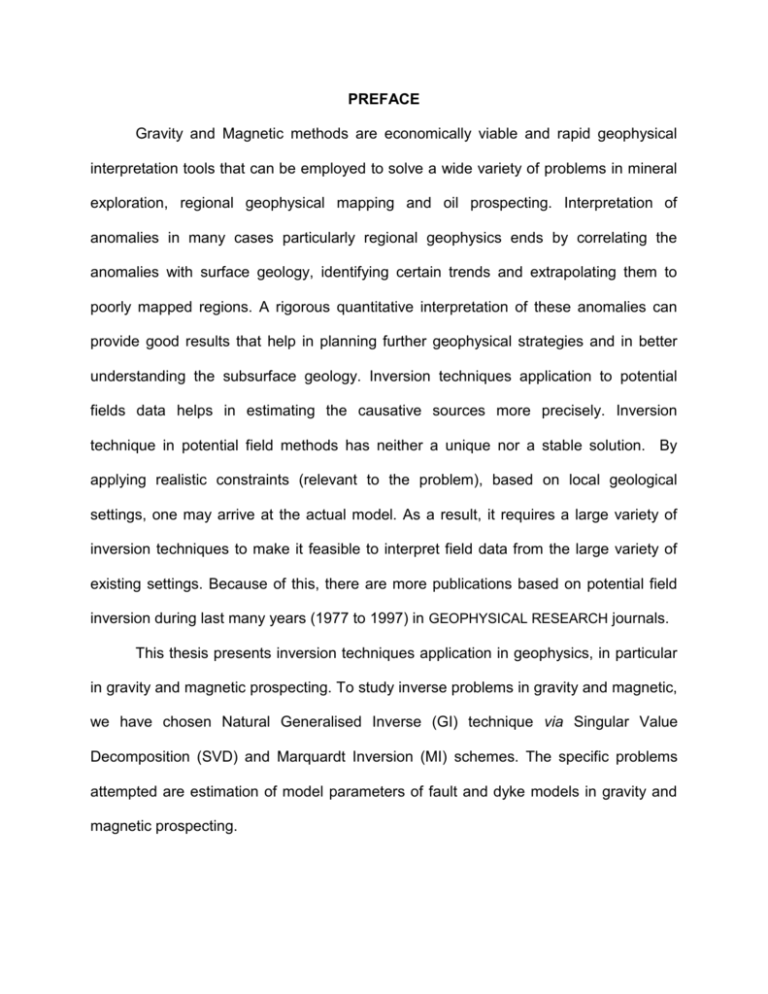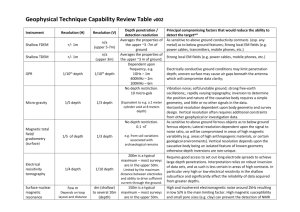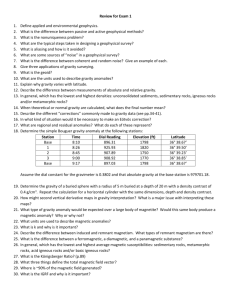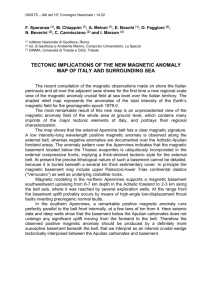Microsoft Word
advertisement

PREFACE Gravity and Magnetic methods are economically viable and rapid geophysical interpretation tools that can be employed to solve a wide variety of problems in mineral exploration, regional geophysical mapping and oil prospecting. Interpretation of anomalies in many cases particularly regional geophysics ends by correlating the anomalies with surface geology, identifying certain trends and extrapolating them to poorly mapped regions. A rigorous quantitative interpretation of these anomalies can provide good results that help in planning further geophysical strategies and in better understanding the subsurface geology. Inversion techniques application to potential fields data helps in estimating the causative sources more precisely. Inversion technique in potential field methods has neither a unique nor a stable solution. By applying realistic constraints (relevant to the problem), based on local geological settings, one may arrive at the actual model. As a result, it requires a large variety of inversion techniques to make it feasible to interpret field data from the large variety of existing settings. Because of this, there are more publications based on potential field inversion during last many years (1977 to 1997) in GEOPHYSICAL RESEARCH journals. This thesis presents inversion techniques application in geophysics, in particular in gravity and magnetic prospecting. To study inverse problems in gravity and magnetic, we have chosen Natural Generalised Inverse (GI) technique via Singular Value Decomposition (SVD) and Marquardt Inversion (MI) schemes. The specific problems attempted are estimation of model parameters of fault and dyke models in gravity and magnetic prospecting. The present work is divided into six chapters. The first chapter presents definitions of some standard inversion schemes given by earlier workers followed by, a brief explanation of an inversion problem and its root, the forward problem. Different inversion problems attempted by different schools are also presented to indicate different directions of development. In addition, inversion studies in different branches of science are briefly surveyed. As the main interest is in the application of the chosen inversion techniques in prospecting, a review of some of the relevant works that appeared during the past decade is also presented. The plan of work being taken up in the thesis is detailed in, “Scope of work “. Error estimation details are presented that include: data and parameter upper bound, relative error, RMS error and artificial error. In each synthetic and field example these details are worked out and discussed. The second chapter is devoted to a detailed description of the forward problems in gravity and magnetic interpretation of fault and dyke models supported by theoretical examples. The mathematical expressions describing fault and dyke anomalies are considered. These expressions are usually referred to as models of fault and dyke. They contain the model parameters, such as depth to the top of the body, width, dip etc., of the geophysical models. A study on the nature of the theoretical anomaly, with changes in the different parameters of the selected model, also forms a part of this chapter. In the third chapter some essential features of inversion are outlined. Using the GI technique with SVD, two synthetic examples are analysed. It is observed that, the numerical experiment with synthetic data works well. The Generalised inverse method solves a mixed determined problem over the whole region of observations and has both data and model resolutions intermediate between the two extremes of over and under determenancies. The fourth chapter deals with the application of GI technique using field data, which is essential to test the performance of the selected techniques. Geophysical data collection and corrections required, before employing the GI technique, are presented in the first part of this chapter. GI application to the corrected gravity and magnetic field data sets forms the other part of the chapter. Two land and one offshore gravity field examples are subjected to GI plus SVD analysis. The results obtained corroborate with the general observation that in the case of gravity anomaly, the density contrast is the dominating model parameter. It is seen in the case of magnetic field data analysis, assuming a dyke model, factor Q (a function of dip of the dyke, field inclination, profile strike) is the crucial parameter The fifth chapter presents in the first part, magnetic data interpretation by Werner deconvolution method, which gives rough estimates of the dyke model. The second part describes Marquardt iteration process, the initial model for which is obtained from Werner model studies. Marquardt iteration process yields updated model in least square sense. Both these methods are explained with application to magnetic data. The second part of this chapter comprises a comparison of the GI and Marquardt inversion schemes and an error analysis of their performance. GI with SVD has additional features like model and data resolutions (i.e., related vectors in model and data space respectively) that enable us to explore details of individual parameter contribution to the geophysical model. Chapter six deals with application of GI technique to compute magnetic basement depth from observed magnetic data of Kakinada -Paradip shelf of eastern continental margin of India. In the present inversion scheme, the topography is equated to a series of juxtaposing prisms, one below each anomaly point and the depths ZT to the top are determined. GI is carried out to refine basement depth along the length of a profile. The same procedure is adapted to all the profiles in an area that enables us to generate magnetic basement map of the area. As a case study, magnetic data between Kakinada (south of Visakhapatnam 17° 41' N, 83° 17' E) and Paradip (20°16' N, 86°42' E), collected - the author is one of the participants in data acquisition cruise - across the continental margin along 40 coast normal profiles (at 10 km interval) are taken to generate magnetic basement map using GI method. In general the basement depth ranges between 2 to 7Km in this off shore region. In the inner shelf off Chilka Lake, shallow basement (< 1km) is inferred corresponding to high amplitude magnetic anomalies of the order of 1800 nT. In the deeper water regions, the basement depth varies from 5 to 7 Km. The significant features from basement map include a) a shallow and highly faulted basement, in the inner shelf, (b) a NE-SW ridge and trough configuration in the mid shelf, c) NW-SE trending basement, off Bhimilipatnam to Kalingapatnam and finally d) N-S trending shallow basement off chilka Lake. From overall analysis, the basement configuration derived form GI technique correlate well with earlier results from conventional methods. FORTRAN 77 codes employed in the numerical computations are also included.





